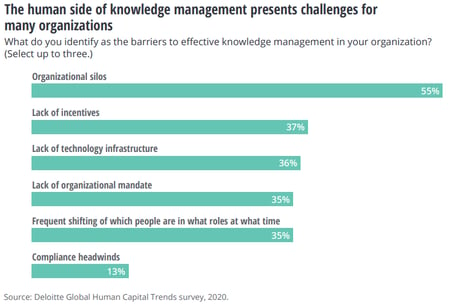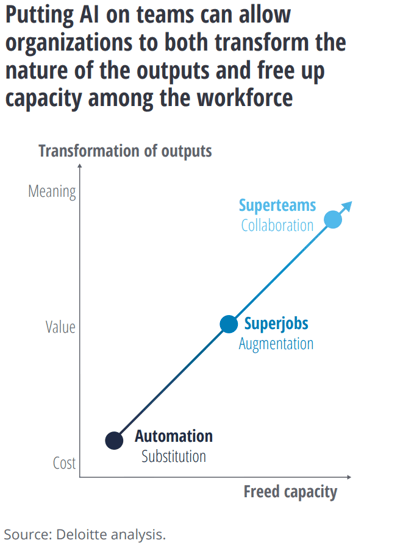Effective Team Communication Strategies for Businesses
Discover how to improve team communication and increase efficiency with clear guidelines, collaboration tools and surveys.
Collaboration and communication are broken in startups. This is a personal story about startup communication problems, costs, and how I'm fixing them.
My startup's mission is to remove communication barriers and break down information silos. I wanted to share my experiences (and horror stories) of why I believe the problem of collaboration is what makes or breaks a business. I've been lucky to have had four distinct leadership roles in fast-growing startups, all of which made it evident that leadership issues are usually not market, process, or technological in nature. I'll elaborate.
I started my career in the nineties before the dotcom bubble burst by designing a web-based B2B sales promotion catalog for a women’s lingerie manufacturer. The role seemed simple enough at first, but I quickly noticed how each stakeholder - the salespeople, lingerie buyers, and marketing all spoke different 'languages' i.e. had different priorities, different words for the same things, and different ways of collaborating.
I learned a lot about the importance of customer interviews and transparent communication to avoid wasted design efforts. You need a detailed level of knowledge to collaborate successfully with subject matter experts. For example, it is not common knowledge to know how to calculate bra size, based on band length and over-the-bust measurements. Gaining an understanding on this level is paramount to be able to communicate with the customer. Little did I know, it would be the first role of many where I dealt with the same issues of communication, knowledge, and information flow between teams, companies, and specialists.
My time at CERN had a big influence on my understanding of the importance of collaboration. I was associated with MIT during the time of the search for the Higgs Boson. It was an important collaborator, but only one of many of the CMS project's 200 institutes from 50 countries. I saw first hand how scientific collaboration at CERN would not happen without a relentless focus on inter-team and inter-cultural collaboration. Working on new releases in the data processing team with physicists, engineers, and technicians taught me the importance of contextual translation.
The same can be said for the business world. I can still vividly remember how I led a new team, which consisted of employees from four different companies: a vendor, a client, and two third-party consultancies. Figuring out their individual needs, bridging them, and creating common goals for us to strive for was challenging to say the least. And the stakes couldn't have been higher. We were running a multi-million, multi-year transformation program. The key was extensive collaboration and open communication. We finally achieved forecastable delivery with high-quality software, and I am really proud of our accomplishment.
Fast forward to 2020, and I found myself pondering the nature of inter-team collaboration and communication, what they could be like in the future, and what would be the critical fix to stop situations getting worse. Based on my experience, nine out of ten problems that tech company leaders encounter are about people, communication, and the flow of information.
After the fourth startup in a row where I was putting out the same fires, I'd had it. I felt like a broken record with my mentoring mantra to each team: knowledge needs to be shared, explain the bigger picture, remote team collaboration requires free access to information and for the love of all that is holy, stop putting up artificial barriers between each other. There has to be a way to fix these simple issues once and for all, right?
 Take a deep look at your work history. Do you remember incidents like these happening?
Take a deep look at your work history. Do you remember incidents like these happening?
A technology company I once worked with had siloed their commercial and technical teams so badly, that both sides refused to use each other's IM tool of choice. The commercial team insisted on lightweight WhatsApping on the fly and the technology team insisted on Slack with fully integrated daily workflows. The leadership didn't see this as an issue (it was their first time in startup-land). They encouraged everyone to send emails to the other teams instead. Well, this encouraged behaviour definitely didn't bridge the gap. At the end of the day, no-one bothered to read the torrent of email chat one-liners flooding their inboxes. When people stop caring about their work, they also start looking for greener pastures.
Another topic that keeps me puzzled is the nature of SaaS per-seat pricing for stingy startups. Is your company really saving money when you are not allowing your product or engineering teams to access information troves like Salesforce? Time and time again I have witnessed weeks of work going down the drain, when eventually one team discovers information, or another team shares information by accident, which invalidates product and feature assumptions of client behaviour and desires. "Well, no one asked."
How many times do your star employees need to waste their effort and commitment before they conclude their service is valued more elsewhere? In the worst case, this star performer has put in extra hours to complete the work on time. For someone who is productive and driven, it might only take that one time before they call it quits.
People come and go in startups, that's the nature of growth business, where the type of people needed changes over time. So why add to the burden of churn by losing your star players, who want to grow and be part of the journey, with internal communication stupid mistakes? The more critical knowledge you only have in key employees' heads the more detrimental the effect. It is often said that documentation and admin is the red tape of the corporate world and hence needs to be fought against to make the company agile. That is a fallacy.  Companies live on knowledge and can't afford to be reinventing the wheel again and again. Poor communication, bad collaboration habits, and lost faith towards the execution of the company's vision can cause the information maintainer to leave, and then that knowledge is gone for good.
Companies live on knowledge and can't afford to be reinventing the wheel again and again. Poor communication, bad collaboration habits, and lost faith towards the execution of the company's vision can cause the information maintainer to leave, and then that knowledge is gone for good.
The above examples are backed by industry research. Deloitte found in its 2020 Deloitte Global Human Capital Trends report that 55% of respondents reported organizational silos as the top barrier to knowledge sharing and management.
Have you ever had two teams working on the same project and calculated the opportunity cost of what it cost to do everything twice? Or what would the impact be of every productive employee staying with you for six months longer? Startups spend staggering amounts of cash on easily fixable mistakes instead of going toward developing the business.
Let's do an example of a London-based online tech company:
Now, let's say because of improved collaboration and communication, the onboarding speed increases by 10% nominally, productivity by 10%, and employee retention is 20% longer. In this example:
I use employee lifetime value to quantify the impact of happy and productive employees at Flowtrace. You can read more about ELTV, wasted cash, and productivity from our how-it-works page.
 Startups and leadership have steadily become more data-driven. Why is it that such fundamental parts of an organization, communication and information sharing, still lack metrics on which to base decisions? Decision are still based on hunches; subjective, opinion-based data gathering is ripe for change. Organizational processes in some cases feel like they have stayed in the 1920s assembly line mindset when everything else has moved on to the 2020s.
Startups and leadership have steadily become more data-driven. Why is it that such fundamental parts of an organization, communication and information sharing, still lack metrics on which to base decisions? Decision are still based on hunches; subjective, opinion-based data gathering is ripe for change. Organizational processes in some cases feel like they have stayed in the 1920s assembly line mindset when everything else has moved on to the 2020s.
I am a firm believer in Peter Drucker's now-famous quote “If you can’t measure it, you can’t improve it.” and this especially rings true in growing companies. So how come we don't have a way to measure collaboration and communication?
It's 2020's guys and gals, and we have been able to measure how people collaborate for a good part of this century because of the digitalization of the workplace and the penetration of digital collaboration tools. We can analyze all the digital footprints that employee communication and collaboration leave behind. Based on the information flow, the communication map, topics that your team is working on, we can show how aligned your team's actions are with the company's business strategy. This can all be done without violating privacy, by analyzing the meta data instead. Metadata in this context would be answering questions like:
This is how we can measure, analyze, and alert our clients to take corrective action based on our common suggestions. It is up to you to decide if you want to go with the suggestion or decide to do something else as you know your company inside out.
Bring your communication and collaboration on par with the rest of the company's metrics. It's time to create a positive, data-driven inspect-adapt-improve cycle. You can read how on our site:
If we view the future of work through the lens of the coming onslaught of automation, the fourth industrial revolution, we can see that there are difficult decisions ahead. How do people fit into this future? The dream is a future where every employee can self-actualize, enjoy their socially connected workplace, and get to do the best possible work without work politics and bargaining.
Contrary to the constant fear mongering about automation and how artificial intelligence will replace us, I don't see machines controlling what employees do. There are aspects of our jobs we will happily automate, but ultimately it is us, who will define what the future looks like. People will always think up more things to do and where they can be useful.
 Startups, scaleups, and established companies will reap the productivity benefits of time freed by automation and augmentation of human capabilities with artificial intelligence. Retrospectively, in the past 20 years, productivity gains for knowledge workers have been primarily driven by automation replacing tedious tasks. As of late, more jobs have been augmented with artificial intelligence which has freed up even further time. A Human Capital Trends report by Deloitte writes that the next logical step in this evolution is the concept of superteams. Superteams leverage artificial intelligence to drive productivity within their organization wider than one job could do in isolation. I couldn't agree more.
Startups, scaleups, and established companies will reap the productivity benefits of time freed by automation and augmentation of human capabilities with artificial intelligence. Retrospectively, in the past 20 years, productivity gains for knowledge workers have been primarily driven by automation replacing tedious tasks. As of late, more jobs have been augmented with artificial intelligence which has freed up even further time. A Human Capital Trends report by Deloitte writes that the next logical step in this evolution is the concept of superteams. Superteams leverage artificial intelligence to drive productivity within their organization wider than one job could do in isolation. I couldn't agree more.
There is no doubt in my mind. I'll always choose the future which is 100% driven by Team Human. We at Flowtrace are working towards a future, where:
🔗 The future is about collaboration
🤼 Progress is driven by human relationships
🏭 Knowledge work is not measured like a 1920s assembly line
🤹 We take control of the information juggling of modern work
I've always known I will take the step to become an entrepreneur one day. That day came over the Christmas holidays 2019 when I managed to articulate what it was that I had known all this time through international collaborator to tech company leader. I took the decision before the world changed overnight with the pandemic, and remote work became the norm. The issues have only been exacerbated, and there is no better time to embark on a journey to remove communication barriers and break down information silos. A company with the right mission and the right product to make knowledge more transparent will solve a real problem.
I would love to have you onboard on our journey. Please let us know if you have similar examples of work communication in the comments below, or on our social media!
Learn what we do to fix the problem once and for all:
Petri Lehtonen
Founder & CEO of Flowtrace
Discover how to improve team communication and increase efficiency with clear guidelines, collaboration tools and surveys.
Flowtrace's Advanced Slack Analytics improve workplace productivity and communication, with features like employee dashboard, surveys, and...
Case Study: How Aptus.AI improved communication, employee engagement, and development efficiency with Flowtrace's company analytics platform.